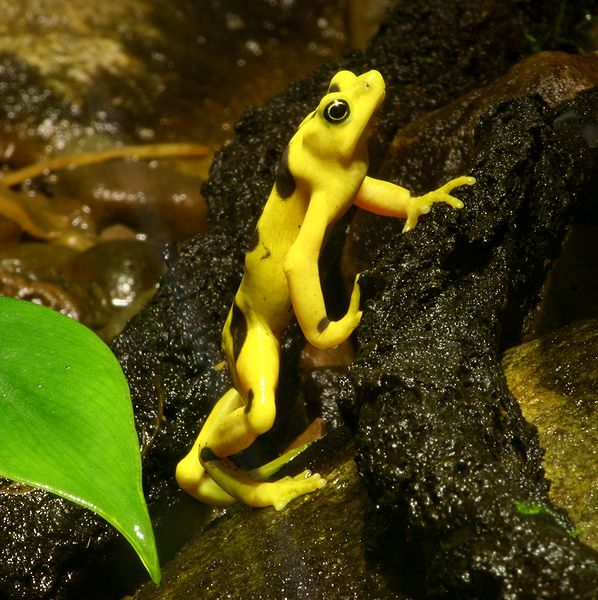The huge, aquatic, baggy-skinned Lake Titicaca Frog (Telmatobius culeus) has fascinated me since childhood, when I first came upon a group at the Bronx Zoo. I returned again and again to stare as the unusual beasts – largest of the world’s aquatic frogs – did “push-ups” at the bottom of their cold aquarium (they breathe largely through their loose skin, and rock back and forth in order to increase the area exposed to the water). Because the frogs lived for so long – nearly 30 years in one case – I was able to work with same individuals I had earlier observed once I began my zoo-keeping career. Read More »
Tag Archives: Frog Conservation
Feed SubscriptionThe Unique, Endangered Panamanian Golden Frog or Harlequin Toad – Part 2
Please see Part I of this article to learn about the natural history of the Panamanian Golden Frog , Atelopus zeteki, including it’s unique mode of communication.
Status of Wild Populations
Panamanian Golden Frog numbers are plummeting, most likely due to an epidemic of the largely incurable fungal infection

Chitridiomycosis. The fungus responsible, Batrachochytrium dendrobatidis, has been implicated in the declines and extinctions of numerous amphibian species worldwide. This frog is also threatened by deforestation, stream siltation, pollution and collection for use as a promotional tool in Panama’s restaurant, hotel and tourism industries (this practice is illegal, but enforcement is often lax).
It is estimated that Golden Frog populations have declined by 80% in both numbers and extent of occurrence over a 10 year period. At least 2 distinct populations are extinct, with 1 such extinction occurring within the span of several months. Golden Frogs are designated as “Critically Endangered” by the IUCN and listed on Appendix I of CITES. They are legally protected by Panama and the subject of a cooperative rescue program, administered by the USA and the Republic of Panama, known as “Project Golden Frog”. Fortunately, the Golden Frog breeds well in captivity.
Unique Skin Toxins
This frog’s skin contains extremely virulent nerve toxins that differ from those produced by other amphibians. Known as “zetekitoxins”, the poison contained in the skin of a single 2-inch-long frog is sufficient to kill 1,200 mice! It is believed that these toxins are produced in association with symbiotic bacteria, but this has not yet been definitively documented.
Cultural Significance
The Panamanian Golden Frog is the national animal of the Republic of Panama, and has traditionally been associated with matters relating to good fortune. Pre-Columbian indigenous people molded its likeness in gold and clay talismans known as “huaces”.
Further Reading
You can learn more about Project Golden Frog by clicking here.
Reptile and Amphibian Conservation: Volunteer Opportunities Involving Field Research
The Partnership for Amphibian and Reptile Conservation (http://www.parcplace.org/) presents a unique opportunity for hobbyists and others to work in the company of professional herpetologists. The organization is unique and, in my opinion, far-sighted, in focusing on common as well as rare amphibians and reptiles. Membership is open to all interested persons.
Working groups are established to address species native to each of 6 geographic regions in the USA, as well as in Canada and Mexico, and volunteers are always welcomed. Current initiatives range from monitoring smooth green snake populations to assessing vernal pond habitats.
Frog and salamander enthusiasts can participate in the National Wildlife Federation’s “Project Frogwatch” (www.nwf.org/frogwatchUSA) or the North American Amphibian Monitoring Program (www.pwrc.usgs.gov/naamp). Amphibian deformities, an increasingly common concern, can be reported at www.nbii.gov/portal/server.pt.
State wildlife agencies often support volunteer-based conservation initiatives. Links to the individual agencies (they all have different names) of each state may be found at http://www.fishwildlife.org/ or on the PARK website noted above.
 That Reptile Blog – Reptile, Amphibian and Exotic Pet Care and Information
That Reptile Blog – Reptile, Amphibian and Exotic Pet Care and Information
